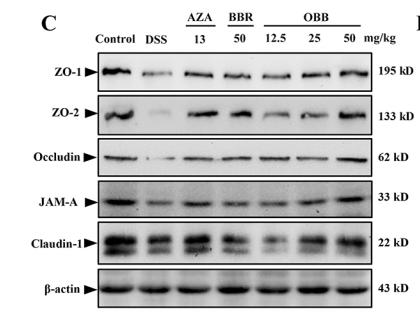ZO-2 Antibody - #DF8632
| Product: | ZO-2 Antibody |
| Catalog: | DF8632 |
| Description: | Rabbit polyclonal antibody to ZO-2 |
| Application: | WB IF/ICC |
| Cited expt.: | WB |
| Reactivity: | Human, Mouse, Rat |
| Prediction: | Pig, Bovine, Horse, Sheep, Rabbit, Dog, Chicken |
| Mol.Wt.: | 133 kDa; 134kD(Calculated). |
| Uniprot: | Q9UDY2 |
| RRID: | AB_2841836 |
Related Downloads
Protocols
Product Info
*The optimal dilutions should be determined by the end user. For optimal experimental results, antibody reuse is not recommended.
*Tips:
WB: For western blot detection of denatured protein samples. IHC: For immunohistochemical detection of paraffin sections (IHC-p) or frozen sections (IHC-f) of tissue samples. IF/ICC: For immunofluorescence detection of cell samples. ELISA(peptide): For ELISA detection of antigenic peptide.
Cite Format: Affinity Biosciences Cat# DF8632, RRID:AB_2841836.
Fold/Unfold
C9DUPq21.11; DFNA51; DUP9q21.11; Friedreich ataxia region gene X104 (tight junction protein ZO-2); MGC26306; PFIC4; Tight junction protein 2; Tight junction protein ZO 2; Tight junction protein ZO-2; TJP2; X104; ZO 2; ZO-2; ZO2; ZO2_HUMAN; Zona occludens 2; Zona occludens protein 2; Zonula occludens protein 2;
Immunogens
A synthesized peptide derived from human ZO-2, corresponding to a region within the internal amino acids.
This protein is found in epithelial cell junctions. Isoform A1 is abundant in the heart and brain. Detected in brain and skeletal muscle. It is present almost exclusively in normal tissues. Isoform C1 is expressed at high level in the kidney, pancreas, heart and placenta. Not detected in brain and skeletal muscle. Found in normal as well as in most neoplastic tissues.
- Q9UDY2 ZO2_HUMAN:
- Protein BLAST With
- NCBI/
- ExPASy/
- Uniprot
MPVRGDRGFPPRRELSGWLRAPGMEELIWEQYTVTLQKDSKRGFGIAVSGGRDNPHFENGETSIVISDVLPGGPADGLLQENDRVVMVNGTPMEDVLHSFAVQQLRKSGKVAAIVVKRPRKVQVAALQASPPLDQDDRAFEVMDEFDGRSFRSGYSERSRLNSHGGRSRSWEDSPERGRPHERARSRERDLSRDRSRGRSLERGLDQDHARTRDRSRGRSLERGLDHDFGPSRDRDRDRSRGRSIDQDYERAYHRAYDPDYERAYSPEYRRGARHDARSRGPRSRSREHPHSRSPSPEPRGRPGPIGVLLMKSRANEEYGLRLGSQIFVKEMTRTGLATKDGNLHEGDIILKINGTVTENMSLTDARKLIEKSRGKLQLVVLRDSQQTLINIPSLNDSDSEIEDISEIESNRSFSPEERRHQYSDYDYHSSSEKLKERPSSREDTPSRLSRMGATPTPFKSTGDIAGTVVPETNKEPRYQEDPPAPQPKAAPRTFLRPSPEDEAIYGPNTKMVRFKKGDSVGLRLAGGNDVGIFVAGIQEGTSAEQEGLQEGDQILKVNTQDFRGLVREDAVLYLLEIPKGEMVTILAQSRADVYRDILACGRGDSFFIRSHFECEKETPQSLAFTRGEVFRVVDTLYDGKLGNWLAVRIGNELEKGLIPNKSRAEQMASVQNAQRDNAGDRADFWRMRGQRSGVKKNLRKSREDLTAVVSVSTKFPAYERVLLREAGFKRPVVLFGPIADIAMEKLANELPDWFQTAKTEPKDAGSEKSTGVVRLNTVRQIIEQDKHALLDVTPKAVDLLNYTQWFPIVIFFNPDSRQGVKTMRQRLNPTSNKSSRKLFDQANKLKKTCAHLFTATINLNSANDSWFGSLKDTIQHQQGEAVWVSEGKMEGMDDDPEDRMSYLTAMGADYLSCDSRLISDFEDTDGEGGAYTDNELDEPAEEPLVSSITRSSEPVQHEESIRKPSPEPRAQMRRAASSDQLRDNSPPPAFKPEPPKAKTQNKEESYDFSKSYEYKSNPSAVAGNETPGASTKGYPPPVAAKPTFGRSILKPSTPIPPQEGEEVGESSEEQDNAPKSVLGKVKIFEKMDHKARLQRMQELQEAQNARIEIAQKHPDIYAVPIKTHKPDPGTPQHTSSRPPEPQKAPSRPYQDTRGSYGSDAEEEEYRQQLSEHSKRGYYGQSARYRDTEL
Predictions
Score>80(red) has high confidence and is suggested to be used for WB detection. *The prediction model is mainly based on the alignment of immunogen sequences, the results are for reference only, not as the basis of quality assurance.
High(score>80) Medium(80>score>50) Low(score<50) No confidence
Research Backgrounds
Plays a role in tight junctions and adherens junctions.
Cell junction>Adherens junction. Cell membrane>Peripheral membrane protein>Cytoplasmic side. Cell junction>Tight junction. Nucleus.
Note: Also nuclear under environmental stress conditions and in migratory endothelial cells and subconfluent epithelial cell cultures.
This protein is found in epithelial cell junctions. Isoform A1 is abundant in the heart and brain. Detected in brain and skeletal muscle. It is present almost exclusively in normal tissues. Isoform C1 is expressed at high level in the kidney, pancreas, heart and placenta. Not detected in brain and skeletal muscle. Found in normal as well as in most neoplastic tissues.
Belongs to the MAGUK family.
Research Fields
· Cellular Processes > Cellular community - eukaryotes > Tight junction. (View pathway)
· Human Diseases > Infectious diseases: Bacterial > Vibrio cholerae infection.
References
Application: WB Species: Mice Sample: colonic tissues
Restrictive clause
Affinity Biosciences tests all products strictly. Citations are provided as a resource for additional applications that have not been validated by Affinity Biosciences. Please choose the appropriate format for each application and consult Materials and Methods sections for additional details about the use of any product in these publications.
For Research Use Only.
Not for use in diagnostic or therapeutic procedures. Not for resale. Not for distribution without written consent. Affinity Biosciences will not be held responsible for patent infringement or other violations that may occur with the use of our products. Affinity Biosciences, Affinity Biosciences Logo and all other trademarks are the property of Affinity Biosciences LTD.
